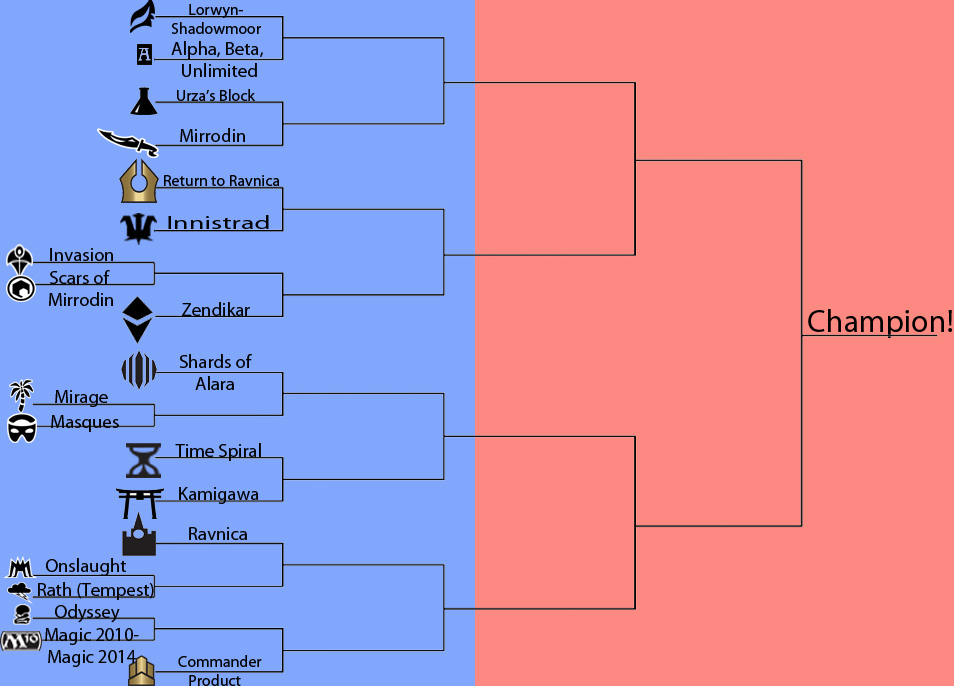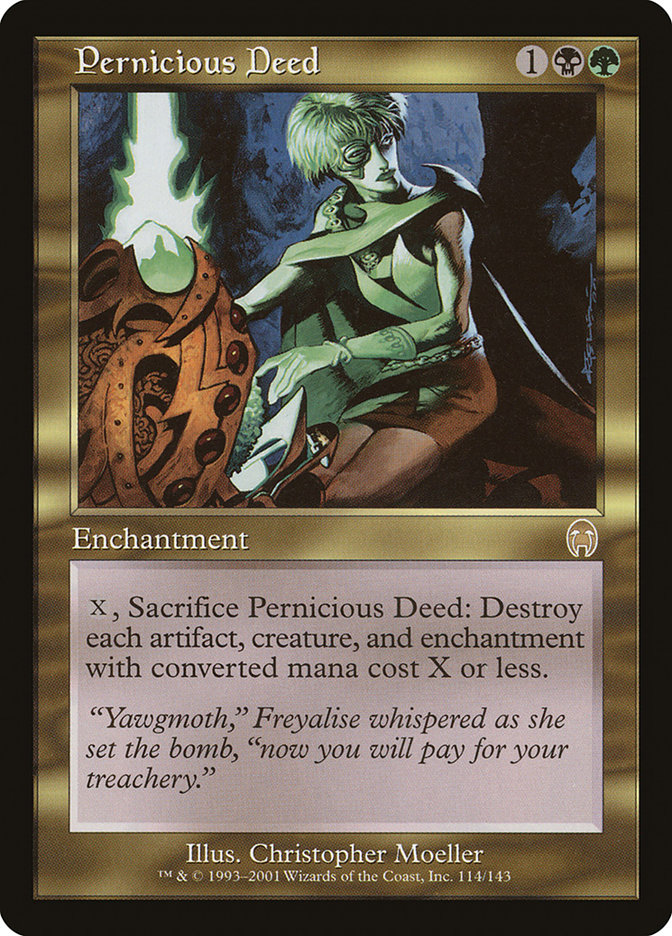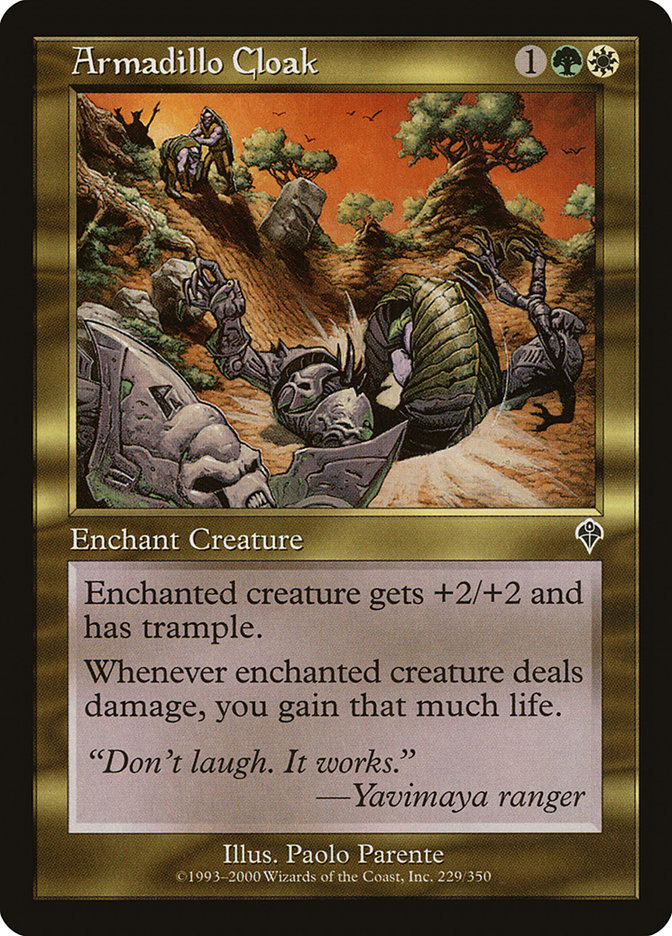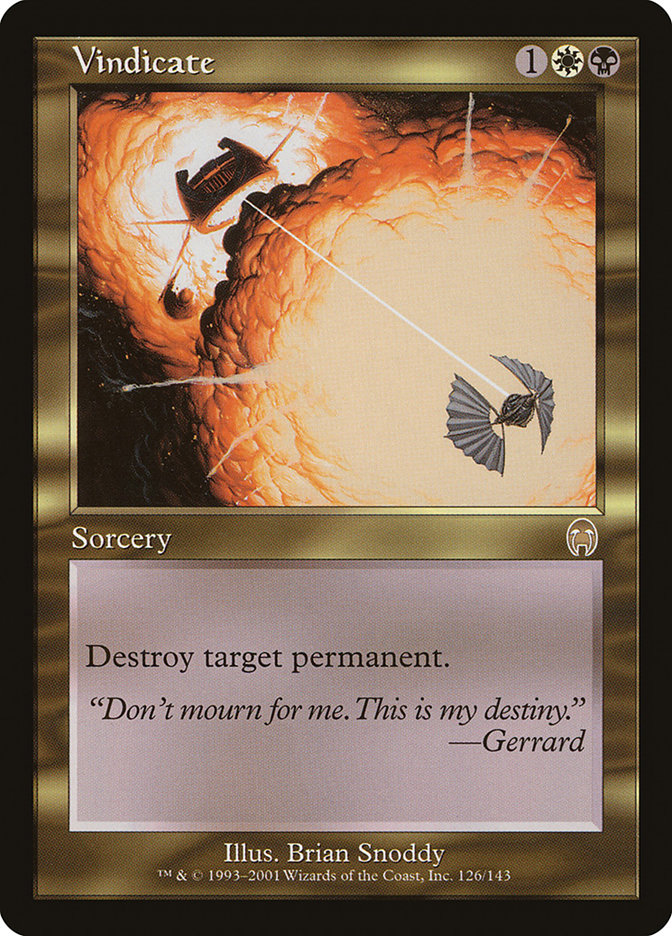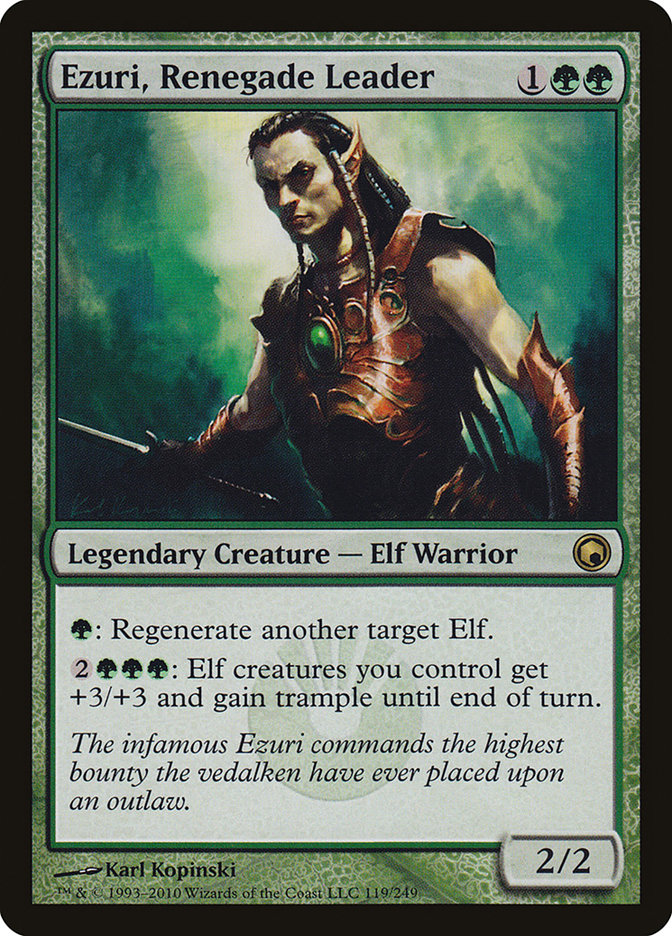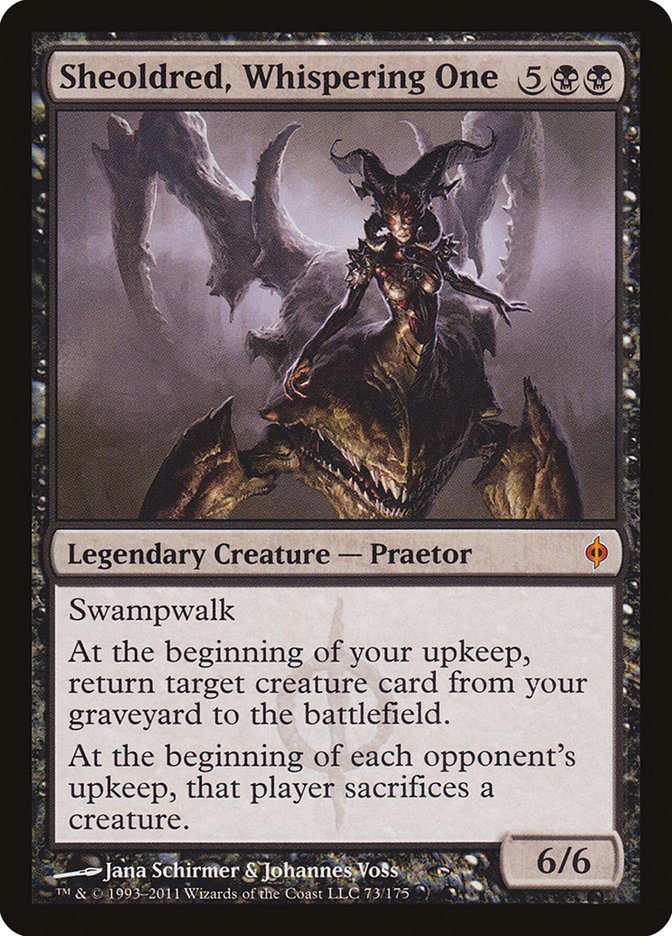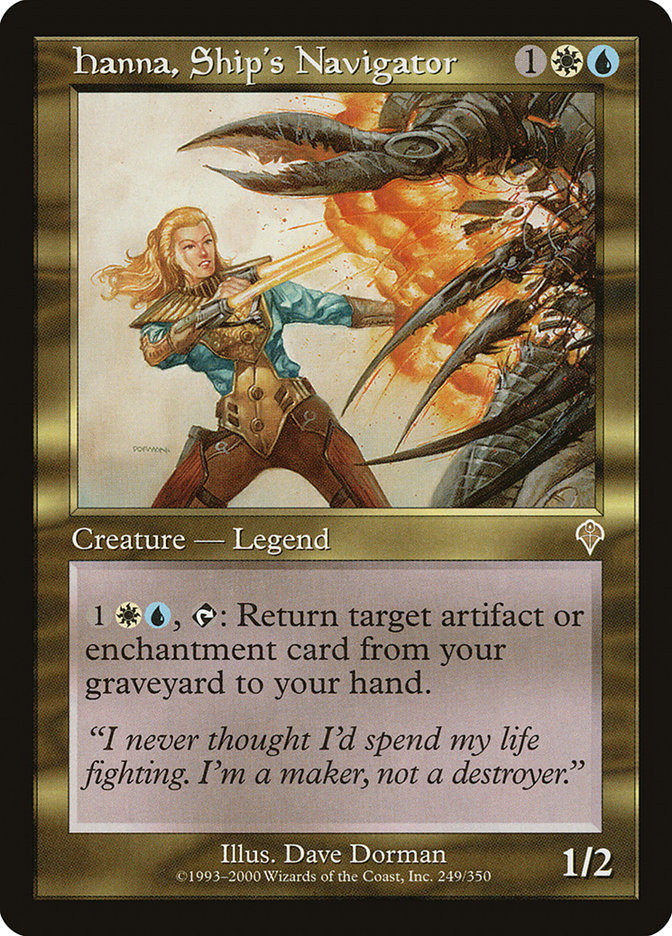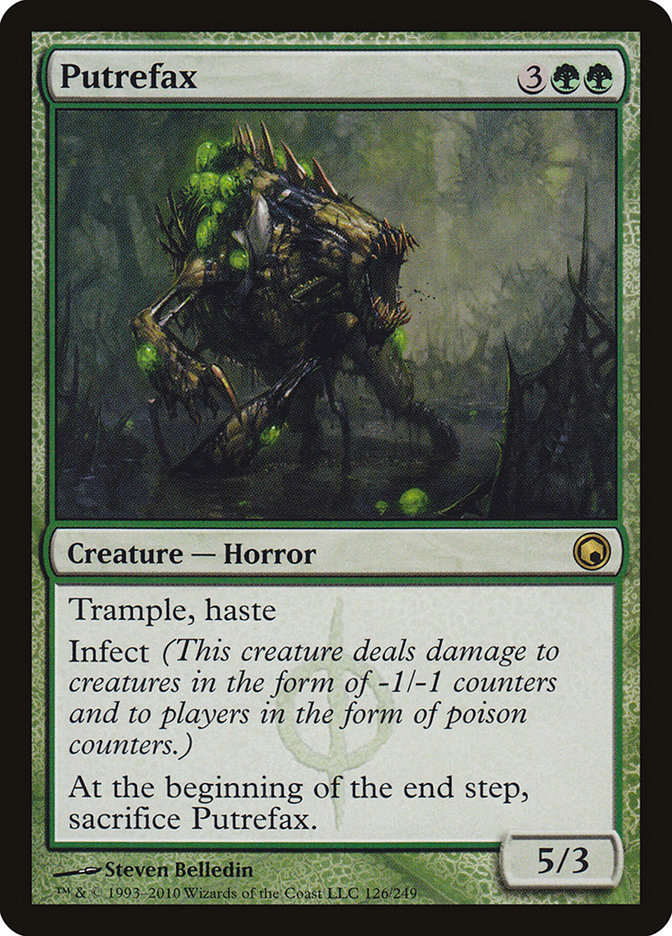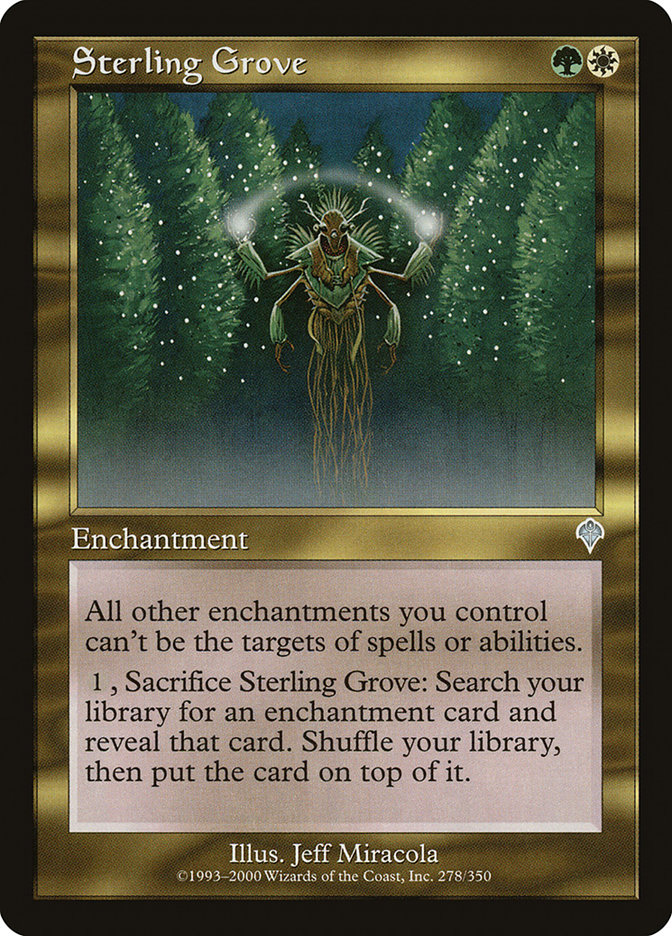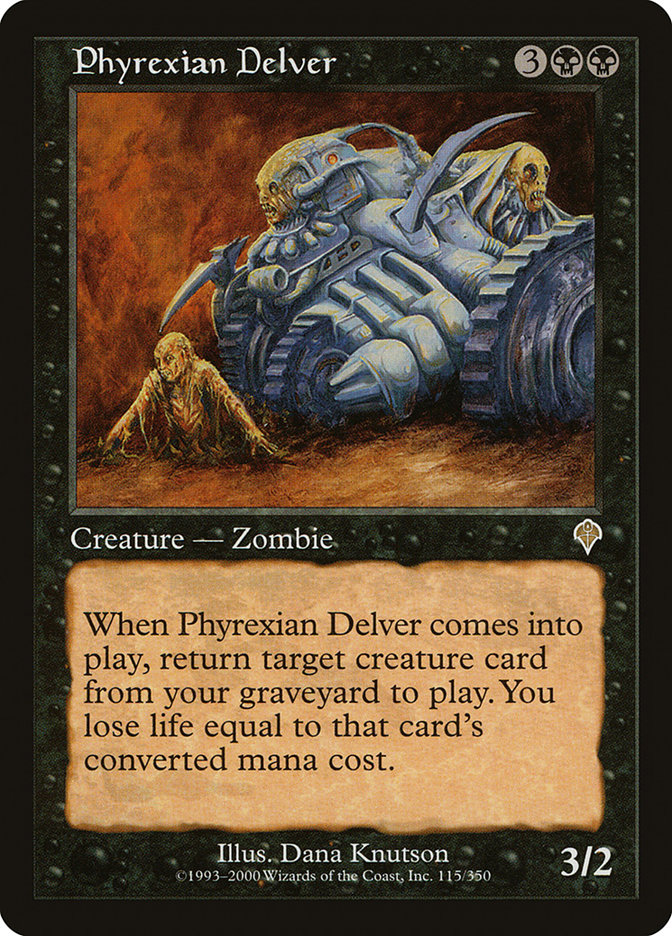Invasion block, consisting of the sets Invasion, Planeshift, and Apocalypse, is a continuation of the story of Gerrard Capashen and the Weatherlight crew as they defend themselves from a headlong invasion of the Phyrexian menace. This block continued a story started in 1997 with the set Weatherlight in Mirage block and finally ended an immense overarching storyline that had been thrust in front of Magic players for the last four years. The end of the Weatherlight saga was met with some mixed reviews; many people loved that most of the card art no longer had to depict the same twelve characters at all times, while others still yearn for a peek at Squee, Goblin Nabob.
This block was one of Wizards of the Coats’s first forays into a dedicated multicolor block, printing a bevy of useful multicolored cards that still see heavy play in Commander decks around the world. This is also where domain, kicker, and split cards made their first appearance.
Scars of Mirrodin Block, consisting of the sets Scars of Mirrodin, Mirrodin Besieged, and New Phyrexia, revisits the mechanical world of Mirrodin. This block had Koth of the Hammer and Elspeth Tirel leading the Mirran resistance against the Phyrexian invasion of Mirrodin; sounds kind of familiar, doesn’t it? Trying to take over another plane, Phyrexia heralded the reintroduction of the poison mechanic with the Mark Rosewater-approved infect. Infect has always been a very contentious issue when it comes to Commander, one that we will go over in the section it belongs in: The Bad. On the bright side, Scars block also brought proliferate, living Weapon and metalcraft to Commander, assisting and creating a bunch of deck archetypes.
With those quick introductions to the battling blocks of this article, let’s take a quick look at the updated bracket!
With Innistrad narrowly squeaking past Ice Age block, it advanced to the Sweet Sixteen and await a Ravnica rumble with the crowd favorite Return to Ravnica. Will the tainted Innistrad block be able to outlast the power of the maze runners? Only Niv-Mizzet Dracogenius knows.
Today’s battle pits two blocks that deal with similar themes with drastically different results. As the Phyrexians invade the planes of both Dominaria and Mirrodin, we get to analyze the impact these blocks had on the greatest casual format ever. They will be compared in five different categories. The Staples that the block brought to the format is our first category, which is followed by the Commander category that speaks to the legendary creatures that are the lifeblood of this amazing format. The Strategies category judges the approaches that were bolstered by the blocks, while the Flavor category is where the oft played but fun cards get a chance to shine. Finally, The Bad is where the blocks can lose points for bringing unsavory things to Commander.
Staples
Invasion block brings the most staples to Commander of any set reviewed so far. We have the Invasion Dragons as stalwarts in big creature decks and Fires of Yavimaya to give them haste. Flametongue Kavu is still played in Riku of Two Reflections, while Fact or Fiction is in every blue deck I’ve seen in the past six years in Commander. Hull Breach gives my favorite colors, red and green, amazing utility, and Aura Shards has been the bane of artifacts and enchantments for years, not to mention cards like Pernicious Deed, Armadillo Cloak, Vindicate, and Void. When was this set made again?
Scars of Mirrodin brings some good utility as well, starting with the Zenith cycle from Mirrodin Besieged and Batterskull in New Phyrexia. The Zeniths, specifically Black Sun Zenith and Green Sun Zenith, see heavy play in their respective colors, while cards like Karn Liberated have allowed every color in Commander access to removal.
In fact, if Scars of Mirrodin block is to be lauded, it’s for the colorless answers it has brought to the format in order to deal with the problems of each color. Both Karn Liberated and Spine of Ish Sah give colors like black and red ways to destroy enchantments while giving green the ability to say "that is dead." Mycosynth Wellspring also lets blue and white decks get the lands they so desperately need in order to stay even with the green ramp decks while buying into the common artifact themes in those colors!
Five Notable Staples From Invasion Block
1) Fact of Fiction
2) Aura Shards
3) Fires of Yavimaya
4) Pernicious Deed
5) Phyrexian Arena
Five Notable Staples From Scars of Mirrodin Block
1) Karn Liberated
2) Zenith Cycle
3) Venser, the Sojourner
4) Birthing Pod
5) Sheoldred, Whispering One
The overwhelming ubiquity of Invasion block cards in Commander decks means that Gerrard and the Weatherlight crew take this round!
Commanders
When it comes to commanders, Scars of Mirrodin block actually created some very new deck archetypes. Glissa, the Traitor innovated a very cool artifact-based strategy that utilizes cards like Executioner’s Capsule and Sylvok Replica to gain a near insurmountable advantage. Sheoldred, Whispering One is a very strong Mono-Black Stax commander, while Thrun the Last Troll is the best Mono-Green Voltron deck in the format. Ezuri, Renegade Leader also masquerades as the best Mono-Green Elves general now that Rofellos, Llanowar Emissary has received a much-deserved smack with the Commander banhammer.
Invasion block, though, brings the heat. Hanna, Ship’s Navigator is the premier U/W artifact and enchantment legend, making cards like Flight of Fancy shine, not to mention the irrational control an Ertai, the Corrupted deck can bring to the game by finally finding a use for cards like Despondency and Hatching Plans. Rith, the Awakener is more than Brain Kibler’s Invitational card; it’s also one of the best Naya generals, bringing general damage and churning out tokens with every smack. Captain Sisay is a toolbox general, bringing a silver bullet for every situation and the ability to easily tutor for great creatures, lands, and artifacts.
Another, albeit not easy, win for Gerrard and the amazing Weatherlight crew. I didn’t even have to bring up the super-secret Kangee, Aerie Keeper deck. I’ve died to that thing 75% of the time.
Strategies
Although I don’t exactly agree with it, Scars did bring a very interesting strategy to Commander in Infect. Neutralizing the core tenant of Commander by giving opponents’ an effective life of ten, cards like Triumph of the Hordes and Putrefax allow players to subvert life gain strategies by only needing to deal ten infect damage. Besides Mark Rosewater favorite mechanic, proliferate has allowed decks like Vorel of the Hull Clade and Exava, Rakdos Blood Witch to easily anthem their teams for a very low cost.
On top of that, cards like Sword of Feast and Famine have heavily influenced Voltron decks by giving them access to the mana doubling effect they never knew they wanted. Xenograft has helped ally strategies beef up their ranks, and Furnace Celebration lets sacrifice decks deal real damage, not to mention Mindcrank giving Dimir mill decks a way to actually end the game when combined with a card like Bloodchief Ascension or Duskmantle Guildmage.
Invasion block also helped Voltron strategies by bringing cards like Dueling Grounds and Armadillo Cloak to the table. Going a little deeper, Sterling Grove lets enchantment-based decks not only protect but find the perfect card for each situation. Painful wheel decks get Urza’s Guilt and Phyrexian Tyranny to punish payers for drawing and discarding cards. All the Sunforger players received Suffocating Blast, Orim’s Thunder, and Backlash in Invasion block to battle those horrible Phyrexians, not to mention how much value the average Phyrexian Delver gets in a Karador, Ghost Chieftain or Teneb the Harvester deck. Invasion block is nuts.
Invasion was also one of the first blocks to get multicolor right, with domain and a smattering of quality gold cards. It takes the category and is looking like a true force in this tournament.
Flavor
If there is one thing Invasion block did right—and it did many—it’s flavor. The story in this set oozes from each card and transcends just the flavor text to be told through the art itself. When Urza finds his brother Mishra in the mires of Phyrexia, he becomes overwhelmed with both rage (Urza’s Rage) and guilt (Urza’s Guilt), causing him to go mad and battle Gerrard Capashen in the Phyrexian Arena. After severing his head in the arena, Gerrard Capashen completes the Legacy Weapon by placing his head within the Skyship Weatherlight and using it to Obliterate the Phyrexian menace.
Scars of Mirrodin block also brings some heavy flavor to the table, with cards like Glistening Oil and Glissa’s Scorn showcasing the intricacies of the block. But let’s be honest; Glistening Oil is cool and all, but it just isn’t Invasion block. At this point, going into The Bad, this might be a clean sweep.
Invasion block wins!
The Bad
Shoot, looks like infect is in Scars of Mirrodin block and not Invasion block. Well, this is a no contest. Let’s talk about infect and let the battle end for the massively outmatched Scars of Mirrodin.
The reason people start at 40 life in Commander is to let them play their deck. This concept isn’t exactly a new one, but it’s extremely important to explain the intrinsic problem with infect. The 40-life buffer lets people pilot a 99-card singleton deck that they’ve spent upwards of two hours creating in a semi-safe environment. This extra time that can add around four additional turn cycles to a game allows the wacky and zany to coexist with the competitive and focused side of Commander.
Infect does not allow this to happen. Either through a hasty Putrefax or a blowout from Triumph of the Hordes, infect ends the game. This isn’t always a bad thing; infect prevents players from just casting Beacon of Immortality, sitting behind a Wall of Reverence for the entire game, and then dropping Test of Endurance for the win. But this is Commander, and there is already a rule that takes care of this: Commander damage. Infect just doesn’t fit in a format tailor-made to allow games to unfold into epic plays of Political Trickery and Epic Experiments.
Also, Invasion block wins. It is like John Cena in this battle; it isn’t fair.
With that, Invasion block demolishes Scars of Mirrodin block in a clean sweep of all of the categories. The Weatherlight crew looks like a force to be reckoned with going forward. Speaking of the Weatherlight crew, they return in the battle between Masques block and Mirage block next week. Will they win without the support of cards like Phyrexian Arena and Blind Seer? Come back next time and find out!
If you think I got it wrong, let me know in the comments! Any and all opinions welcome!

